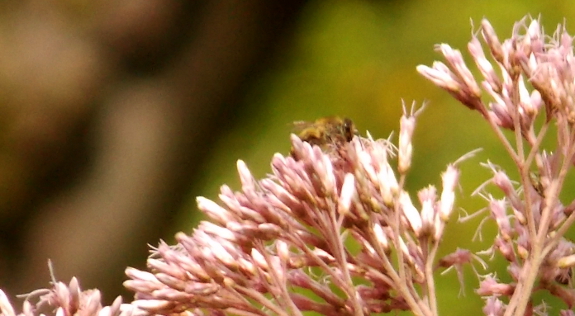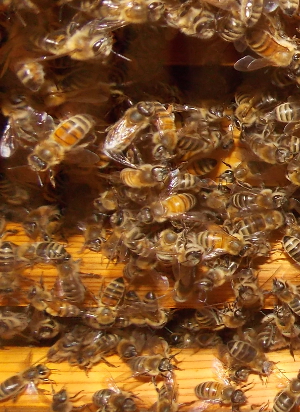
Keeping an eye on varroa mite levels

The bees haven't managed
to do any extra comb-building this week, as evidenced by a photo up
through the bottom of the daughter hive. Sure, there are scads of
flowers available at the moment, but bees can't fly when it's raining
every day. Luckily, both of  our colonies have socked away so much honey that they could probably coast until winter if they had to.
our colonies have socked away so much honey that they could probably coast until winter if they had to.
Honey is on my mind
because this is the time of year to start thinking about the hives'
winter survival. But survival through the cold months doesn't just
mean honey stores. Varroa mites can be a huge drain on a hive's
resources in the winter, and the populations sometimes balloon in late
summer and early fall. So I like to do a mite check
in August, another in September, and one more in October just to make
sure the colonies are on track. Our two hives passed with flying
colors during this first round --- the daughter hive dropped two mites
per day while the mother hive dropped 1.3 mites per day, far below the
worrisome threshold.
What will we do if mite levels rise over time? We already use a lot of the methods of varroa-mite treatment/prevention listed here. Last year, we tried out treating bees with powdered sugar
as well, but I don't think I'd do that again --- it could be just a
coincidence, but the hive dosed with sugar is the only one where I've
ever had a colony abscond in the fall. Instead, I might try the rhubarb trick that an old-timer recently shared with me. Better yet, here's hoping our hygenic bees will groom off so many varroa mites that I won't have to do anything at all.
Want more in-depth information? Browse through our books.
Or explore more posts by date or by subject.
About us: Anna Hess and Mark Hamilton spent over a decade living self-sufficiently in the mountains of Virginia before moving north to start over from scratch in the foothills of Ohio. They've experimented with permaculture, no-till gardening, trailersteading, home-based microbusinesses and much more, writing about their adventures in both blogs and books.
Want to be notified when new comments are posted on this page? Click on the RSS button after you add a comment to subscribe to the comment feed, or simply check the box beside "email replies to me" while writing your comment.
- Remove comment
